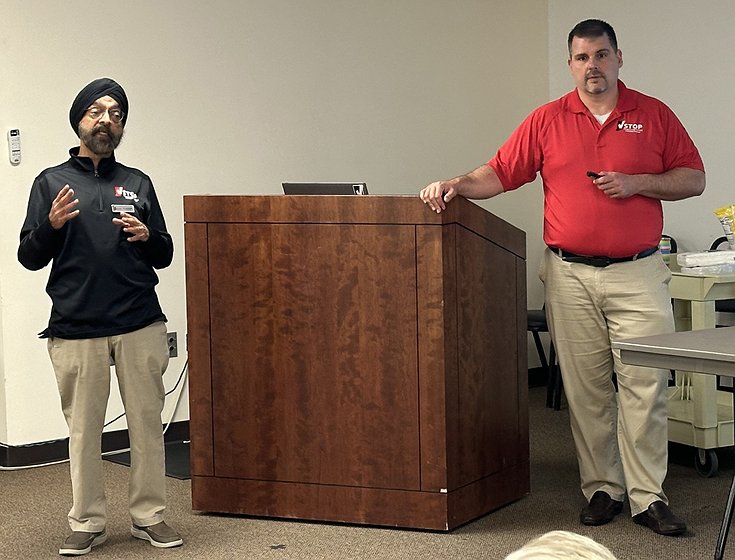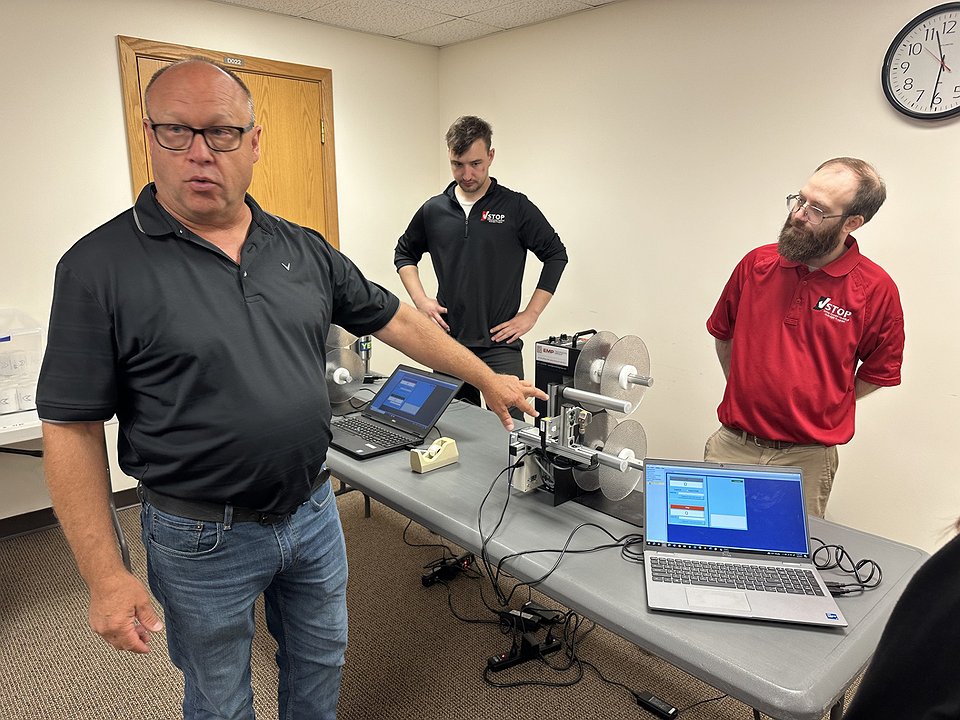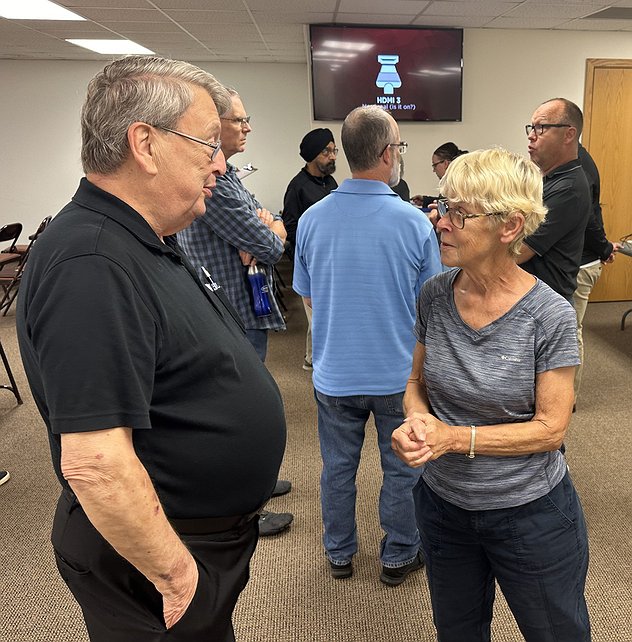VSTOP Audits Kosciusko County’s Voting Systems, Outcomes
June 5, 2024 at 9:42 p.m.

Post-election audits are more complicated than just a roll of the dice, but a couple die were involved Wednesday in getting the process started.
Before VSTOP (Voting System Technical Oversight Program) began the post-election audit of Kosciusko County’s voting systems and primary election outcomes, a presentation was given to the public and local officials on the audit process in the multipurpose room of the Justice Building.
 Dr. Chad Kinsella (R), VSTOP co-director and Ball State University associate professor of political science, and Dr. Jay Bagga (L), VSTOP co-director and BSU professor of computer science, explain what a post-election audit is during a public presentation Wednesday in the multipurpose room of the Justice Building. Photo by David Slone, Times-Union
Dr. Chad Kinsella (R), VSTOP co-director and Ball State University associate professor of political science, and Dr. Jay Bagga (L), VSTOP co-director and BSU professor of computer science, explain what a post-election audit is during a public presentation Wednesday in the multipurpose room of the Justice Building. Photo by David Slone, Times-UnionDr. Chad Kinsella, VSTOP co-director and Ball State University associate professor of political science, said the first Indiana post-election audit was done in 2018 in Marion County, piloted by VSTOP. Following that, the Indiana secretary of state then and secretaries since then have endorsed the audits and want to continue them. Colorado was the first state to have post-election audits, with other states following.
“It’s supported by the Election Assistance Commission, which is a federal entity; National Association of Secretaries of State; National Conference of State Legislatures; The Brennan Center and on and on and on. It’s just kind of this gold standard of auditing procedures. So there’s a whole lot of different groups that have endorsed doing this,” Kinsella said.
Since 2018, VSTOP has conducted 24 post-election audits in 23 counties, with audits being conducted in Marion County twice. With audits so far this year, he said Kosciusko County was the 26th audited county and 27th audit.
“A post-election audit is an audit protocol that makes use of statistical methods designed to limit acceptable levels of risk in certifying preliminary election outcome that constitute incorrect outcome,” Kinsella said. “Basically, what all of this is, without using the complex definition, is this is one tool among many to go back and check and make sure that everything was done correctly.”
He said they sample ballots until they can show confidence.
On the voting system, before a person hits the red button to cast their vote, the voter gets to look at a paper to make sure their vote is correct.
“What we will be comparing is the electronic, what people saw on the screen, what’s downloaded, versus the paper ballot. Again, what they should do is match 100% of the time,” Kinsella said.
Kosciusko County uses MicroVote Systems, which are Direct Recording Electronic (DRE) Voting Systems. They have a Cast Vote Record (CVR), which is the digital record of the ballot, and a Voter Verified Paper Audit Trail (VVPAT), which is the paper record of the ballot. The two records should match exactly.
Dr. Jay Bagga, VSTOP co-director and BSU professor of computer science, explained, “A post-election audit is a sampling of ballots. It’s not a recount. ... A recount by law is a very different process where you can count all the ballots if there’s questions. A recount, of course, is looking at all the ballots again. A post-election audit only takes a small sample of ballots and gives you large confidence, and we’re going to do 99% confidence today.”
Someone may wonder why not 100% confidence. Bagga explained, “That’s recount, if you want 100. And even then, with a recount, it’s likely that there are many other errors that get introduced - human errors, accounting errors. But this gives you a 99% confidence.”
Matt Housley, VSTOP elections systems audit specialist, discussed the comparison audit terminology, such as risk limit and confidence level.
“So the risk limit, that is the percent chance that this audit would not catch an error if there was one. Again, 1%, that is as low as we can get that without doing a full recount,” he said. “The confidence level, that is just the flip side, so the percent chance that the audit would catch an incorrect outcome or correct an error if there was one. So, again, 99% there. This is as good as it gets in terms of being able to audit election results.”
VSTOP on Wednesday looked at the comparison between the VVPAT to the digital CVR. Housley said the match rate should always be 100% because the digital record should always match the paper record of what the voter did.
“So today what we’re looking for is a 100% match rate on every ballot that we inspect. So that’s what we’re going to be looking for today,” he stated.
VSTOP audited election day ballots Wednesday and all the election day rolls were on hand. To conduct the audit, VSTOP used the Stark Audit Tool, audit software developed by Dr. Philip Stark from the University of California Berkley Department of Statistics.
“This tool has been used across the country in various different ways for post-election audits. It’s been found to be an effective tool for use, which is why we’re using it today,” Housley said.
To generate the random seed number, which assists the Audit Tool in selecting the random sample of ballots, VSTOP had various individuals from the county and public participate in the rolling of a 10-sided die to generate a 20-digit number, ensuring that the sample is truly random.
The number of ballots that were required for the audit and races that were audited Wednesday included 39 ballots for the county coroner; 35 ballots for county surveyor and 120 ballots for northern district county commissioner. However, since they were auditing 120 ballots for the commissioner race, VSTOP audited 120 ballots for all three races, going above of what was required.
Housley pointed out that they would not see a Democratic race for audit.
“The reason that we are not auditing a Democratic race today is because the ratio of ballots is simply too low,” he said. “There’s just too many Republican voters to Democratic voters because, on these machines, you are not able to separate these ballots into Democratic ballots and Republican ballots.”
As an example, if they needed a sample size of 39 ballots, they may need to sample 400-500 ballots potentially to get the 39 Democratic ballots they would need because it’s going to pull a random sample.
“And, of course, if 90% of the county is Republican who voted, then that means 90% we have a much higher chance of pulling Republican ballots, so that’s why today you will not see a Democratic race in the audit,” Housley said. “The good thing is, is that, again, Republicans and Democrats alike use these same machines. So if there was going to be some kind of error that we would catch, we also would be able to know that it would be the same as auditing a Democratic race because those machines are being used by both sets of voters.”
Housley explained the auditing process in detail, from the generation of the random seed number to inspection of the ballots and the rewinder machines. The audit was expected to take up to three hours.
“We’re going to keep doing that until we hit 120 matches. Once we hit 120 matches, then we can put it into the Audit Tool, and as long as there are no bad matches, our audit will be complete,” he stated.
The post-election audit is voluntary.
Kosciusko County Clerk for the Circuit and Superior Courts Ann Torpy said she volunteered for the county to participate in the audit - paid by the Indiana Secretary of State’s office - “because I was excited to show our county voters that these systems are accurate and that it ensures that their votes are being cast and counted properly at the county level on election night so they can be confident in our election results.”
Once the county had the VVPATs, that’s when Kosciusko was able to participate in the auditing process and Torpy volunteered soon after she learned about it.
“So I was really looking forward to being either selected by the state or volunteering because we now have the opportunity to participate in this audit,” Torpy said.
She said she was confident in how the audit was going to turn out, but she wanted voters to be confident, too.
Latest News
E-Editions
Post-election audits are more complicated than just a roll of the dice, but a couple die were involved Wednesday in getting the process started.
Before VSTOP (Voting System Technical Oversight Program) began the post-election audit of Kosciusko County’s voting systems and primary election outcomes, a presentation was given to the public and local officials on the audit process in the multipurpose room of the Justice Building.
 Dr. Chad Kinsella (R), VSTOP co-director and Ball State University associate professor of political science, and Dr. Jay Bagga (L), VSTOP co-director and BSU professor of computer science, explain what a post-election audit is during a public presentation Wednesday in the multipurpose room of the Justice Building. Photo by David Slone, Times-Union
Dr. Chad Kinsella (R), VSTOP co-director and Ball State University associate professor of political science, and Dr. Jay Bagga (L), VSTOP co-director and BSU professor of computer science, explain what a post-election audit is during a public presentation Wednesday in the multipurpose room of the Justice Building. Photo by David Slone, Times-UnionDr. Chad Kinsella, VSTOP co-director and Ball State University associate professor of political science, said the first Indiana post-election audit was done in 2018 in Marion County, piloted by VSTOP. Following that, the Indiana secretary of state then and secretaries since then have endorsed the audits and want to continue them. Colorado was the first state to have post-election audits, with other states following.
“It’s supported by the Election Assistance Commission, which is a federal entity; National Association of Secretaries of State; National Conference of State Legislatures; The Brennan Center and on and on and on. It’s just kind of this gold standard of auditing procedures. So there’s a whole lot of different groups that have endorsed doing this,” Kinsella said.
Since 2018, VSTOP has conducted 24 post-election audits in 23 counties, with audits being conducted in Marion County twice. With audits so far this year, he said Kosciusko County was the 26th audited county and 27th audit.
“A post-election audit is an audit protocol that makes use of statistical methods designed to limit acceptable levels of risk in certifying preliminary election outcome that constitute incorrect outcome,” Kinsella said. “Basically, what all of this is, without using the complex definition, is this is one tool among many to go back and check and make sure that everything was done correctly.”
He said they sample ballots until they can show confidence.
On the voting system, before a person hits the red button to cast their vote, the voter gets to look at a paper to make sure their vote is correct.
“What we will be comparing is the electronic, what people saw on the screen, what’s downloaded, versus the paper ballot. Again, what they should do is match 100% of the time,” Kinsella said.
Kosciusko County uses MicroVote Systems, which are Direct Recording Electronic (DRE) Voting Systems. They have a Cast Vote Record (CVR), which is the digital record of the ballot, and a Voter Verified Paper Audit Trail (VVPAT), which is the paper record of the ballot. The two records should match exactly.
Dr. Jay Bagga, VSTOP co-director and BSU professor of computer science, explained, “A post-election audit is a sampling of ballots. It’s not a recount. ... A recount by law is a very different process where you can count all the ballots if there’s questions. A recount, of course, is looking at all the ballots again. A post-election audit only takes a small sample of ballots and gives you large confidence, and we’re going to do 99% confidence today.”
Someone may wonder why not 100% confidence. Bagga explained, “That’s recount, if you want 100. And even then, with a recount, it’s likely that there are many other errors that get introduced - human errors, accounting errors. But this gives you a 99% confidence.”
Matt Housley, VSTOP elections systems audit specialist, discussed the comparison audit terminology, such as risk limit and confidence level.
“So the risk limit, that is the percent chance that this audit would not catch an error if there was one. Again, 1%, that is as low as we can get that without doing a full recount,” he said. “The confidence level, that is just the flip side, so the percent chance that the audit would catch an incorrect outcome or correct an error if there was one. So, again, 99% there. This is as good as it gets in terms of being able to audit election results.”
VSTOP on Wednesday looked at the comparison between the VVPAT to the digital CVR. Housley said the match rate should always be 100% because the digital record should always match the paper record of what the voter did.
“So today what we’re looking for is a 100% match rate on every ballot that we inspect. So that’s what we’re going to be looking for today,” he stated.
VSTOP audited election day ballots Wednesday and all the election day rolls were on hand. To conduct the audit, VSTOP used the Stark Audit Tool, audit software developed by Dr. Philip Stark from the University of California Berkley Department of Statistics.
“This tool has been used across the country in various different ways for post-election audits. It’s been found to be an effective tool for use, which is why we’re using it today,” Housley said.
To generate the random seed number, which assists the Audit Tool in selecting the random sample of ballots, VSTOP had various individuals from the county and public participate in the rolling of a 10-sided die to generate a 20-digit number, ensuring that the sample is truly random.
The number of ballots that were required for the audit and races that were audited Wednesday included 39 ballots for the county coroner; 35 ballots for county surveyor and 120 ballots for northern district county commissioner. However, since they were auditing 120 ballots for the commissioner race, VSTOP audited 120 ballots for all three races, going above of what was required.
Housley pointed out that they would not see a Democratic race for audit.
“The reason that we are not auditing a Democratic race today is because the ratio of ballots is simply too low,” he said. “There’s just too many Republican voters to Democratic voters because, on these machines, you are not able to separate these ballots into Democratic ballots and Republican ballots.”
As an example, if they needed a sample size of 39 ballots, they may need to sample 400-500 ballots potentially to get the 39 Democratic ballots they would need because it’s going to pull a random sample.
“And, of course, if 90% of the county is Republican who voted, then that means 90% we have a much higher chance of pulling Republican ballots, so that’s why today you will not see a Democratic race in the audit,” Housley said. “The good thing is, is that, again, Republicans and Democrats alike use these same machines. So if there was going to be some kind of error that we would catch, we also would be able to know that it would be the same as auditing a Democratic race because those machines are being used by both sets of voters.”
Housley explained the auditing process in detail, from the generation of the random seed number to inspection of the ballots and the rewinder machines. The audit was expected to take up to three hours.
“We’re going to keep doing that until we hit 120 matches. Once we hit 120 matches, then we can put it into the Audit Tool, and as long as there are no bad matches, our audit will be complete,” he stated.
The post-election audit is voluntary.
Kosciusko County Clerk for the Circuit and Superior Courts Ann Torpy said she volunteered for the county to participate in the audit - paid by the Indiana Secretary of State’s office - “because I was excited to show our county voters that these systems are accurate and that it ensures that their votes are being cast and counted properly at the county level on election night so they can be confident in our election results.”
Once the county had the VVPATs, that’s when Kosciusko was able to participate in the auditing process and Torpy volunteered soon after she learned about it.
“So I was really looking forward to being either selected by the state or volunteering because we now have the opportunity to participate in this audit,” Torpy said.
She said she was confident in how the audit was going to turn out, but she wanted voters to be confident, too.





